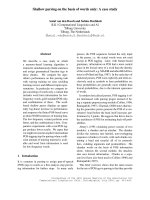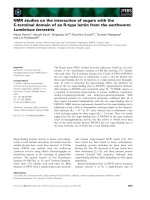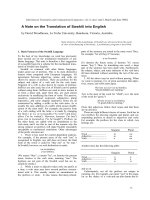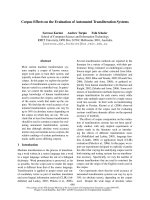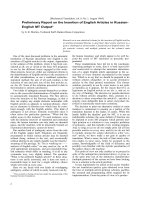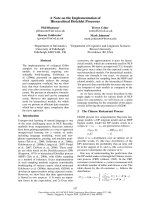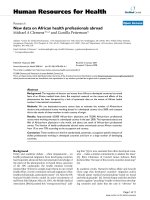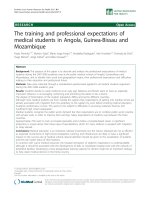Báo cáo sinh học: " Crossbreeding effect on sexual dimorphism of body weight in intergeneric hybrids obtained between " docx
Bạn đang xem bản rút gọn của tài liệu. Xem và tải ngay bản đầy đủ của tài liệu tại đây (442.25 KB, 8 trang )
Original
article
Crossbreeding
effect
on
sexual
dimorphism
of
body
weight
in
intergeneric
hybrids
obtained
between
Muscovy
and
Pekin
duck
Chein
Tai
Roger
Rouvier
a
Taiwan
Livestock
Research
Institute,
Hsin-Hua,
Tainan,
71210
Taiwan,
Republic
of
China
b
Station
d’amélioration
génétique
des
animaux,
Centre
de
recherches
de
Toulouse,
Institut
national
de
la
recherche
agronomique,
BP
27,
31326
Castanet-Tolosan
cedex,
France
(Received
8
December
1997;
accepted
6
March
1998)
Abstract -
From
a
factorial
crossbreeding
experiment
between
two
Muscovy
and
Pekin
duck
strains
it
appears
that
the
increased
body
weight
sexual
dimorphism
in
favour
of
males
in
the
Muscovy
growing
duck
depends
on
the
Muscovy
mother
in
pure
breds
and
in
the
reciprocal
cross.
The
ratio
of
male
to
female
body
weight
averages
took
the
values
of
1.19,
1.47,
1.75, 1.77,
1.84
and
1.64,
respectively,
at
4,
10, 16,
20,
30
and
40
weeks
of
age
in
the
Muscovy
progeny.
This
tendency
was
similar
in
the
Pekin
x
Muscovy
progeny.
On
the
contrary
this
ratio
took
the
values
of
1.07
and
1.11
at
10
and
16
weeks
of
age
in
the
Pekin
progeny,
being
similar
in
the
Muscovy
x
Pekin
progeny
(1.06
1.07
and
1.08,
respectively,
at
16,
20
and
30
weeks
of
age).
These
results
are
evidence
of
a
contribution
of
the
Muscovy
female
duck
to
increase
the
body
weight
sexual
dimorphism
in
duck
by
depressing
the
body
weight
growth
in
female
progeny
and
not
in
the
male
progeny
either
in
pure
or
crossbreeding.
If
the
maternal
effects
are
assumed
to
be
similar
in
male
and
female
progeny, the
ranking
of the
four
genotypes
in
the
female
progeny
could
be
explained
by
adding
to
the
effect
of
sex-linked
genes
(Z
chromosome)
the
effect
of
genes
on
the
W
chromosome.
Within
a
Mendelian
inheritance
pattern
it
may
be
suggested
that,
besides
the
usual
sex-linked
gene
effects,
coding
genes
of
the
non-pseudo-autosomal
region
(NPAR)
of
the
Muscovy
W
chromosome
depress
growth
when
compared
to
the
Pekin
W
chromosome.
@
Inra/Elsevier,
Paris
ducks
/
body
weight
/
sexual
dimorphism
/
crossbreeding
*
Correspondence
and
reprints
Résumé -
Effets
du
croisement
sur
le
dimorphisme
sexuel
en
poids
corporel
chez
les
hybrides
intergénériques
obtenus
entre
les
canards
de
Barbarie
et
Pékin.
Dans
une
expérience
de
croisement
factoriel
entre
deux
souches
de
canards
de
Barbarie
et
Pékin,
il
apparaît
que
le
dimorphisme
sexuel
en
faveur
des
mâles
sur
les
caractères
de
croissance
semble
dépendre
de
la
mère
Barbarie
en
pur
et
dans
le
croisement
réciproque :
le
rapport
entre
les
moyennes
des
poids
corporels
prennent
les
valeurs
de
1,19 ;
1,47 ;
1,75 ;
1,77 ;
1,84 ;
1,64
respectivement
aux
âges
de
4,
10,
16, 20, 30
et
40
semaines
dans
la
descendance
Barbarie.
Les
résultats
sont
comparables
dans
la
descendance
du
croisement
entre
mâle
Pékin
et
femelle
Barbarie.
Au
contraire
ce
rapport,
lorsque
la
différence
entre
poids
des
mâles
et
des
femelles
est
significative,
prend
les
valeurs
de
1,07
et
1,11
aux
âges
de
10
et
16
semaines
dans
la
descendance
des
Pékin.
Cela
est
comparable
dans
la
descendance
du
croisement
entre
le
mâle
Barbarie
et
la
cane
Pékin,
avec
des
valeurs
du
rapport
de
1,06 ;
1,07
et
de
1,08
respectivement
aux
âges
de
16,
20
et
30
semaines.
Ces
résultats
mettent
en
évidence
une
contribution
de
la
cane
Barbarie,
en
pur
et
en
croisement,
à
l’accroissement
du
dimorphisme
sexuel
en
poids
par
un
effet
dépressif
sur
la
croissance
corporelle
sur
sa
descendance
femelle
et
non
sur
sa
descendance
mâle.
Si
les
effets
génétiques
maternels
sont
supposés
être
comparables
dans
les
descendances
mâle
et
femelle,
le
classement
des
quatre
génotypes
dans
le
sexe
femelle
peut
s’interpréter
en
additionnant
aux
effets
de
gènes
liés
au
sexe
(chromosome
Z)
un
effet
de
gènes
qui
seraient
situés
sur
le
chromosome
W.
Dans
le
cadre
de
l’hérédité
Mendélienne,
on
peut
faire
l’hypothèse,
outre
les
effets
habituels
chez
les
oiseaux
de
gènes
liés
au
sexe,
d’un
effet
dépressif
sur
la
croissance
de
gènes
de
la
région
non
pseudo-autosomale
du
chromosome
W
du
Barbarie,
comparativement
au
W
du
Pékin,
si
celle-ci
contient
des
gènes
codants.
©
Inra/Elsevier,
Paris
canard
/
poids
corporel
/
dimorphisme
sexuel
/
croisement.
1.
INTRODUCTION
The
very
large
body
weight
sexual
dimorphism
in
favour
of
males
in
the
Muscovy
duck
is
well
known
[9,
10!.
Moreover,
it
seemed
to
be
small
in
Pekin
duck
as
in
the
progeny
of
the
mating
of
Muscovy
drake
with
Pekin
duck
female
which
gives
the
mule
duck,
and
to
be
as
in
Muscovy
in
the
reciprocal
cross
which
gives
the
hinny
duck
(12).
Olver
et
al.
[8]
have
pointed
out
that
pure
Muscovy
and
Pekin
x
Muscovy
hybrids
showed
a
body
weight
sex
difference
increasing
between
5
and
10
weeks
of
age,
and
that
the
pure
Pekin
and
the
Muscovy
x
Pekin
hybrids
showed
very
little
sex
difference.
Usually
mule
ducks
are
produced,
owing
to
their
meat
production
potential
in
both
sexes
(11!,
but
not
the
reciprocal
hybrids
(hinny
duck).
Gomot
and
Bonin
[5]
studied
the
male
hybrid
between
Pekin
drake
and
Muscovy
female
duck.
They
concluded
that
it
presents
on
the
whole
a
predominance
of
the
maternal
characteristics.
As
far
as
we
know,
there
has
been
no
investigation
up
to
now
to
study
the
differences
in
body
weight
sexual
dimorphism
in
ducks
according
to
the
Muscovy
or
Pekin
mother.
A
crossbreeding
experiment
between
two
Muscovy
and
Pekin
duck
strains
has
been
carried
out.
The
purpose
of
this
work
is
to
show
evidence
of
the
Muscovy
mother
influence
upon
the
body
weight
sexual
dimorphism
during
growth
and
to
discuss related
hypotheses
such
as
the
effects
of
sex-linked
genes
and
the
Muscovy
dam
contribution.
2.
MATERIAL
AND
METHODS
2.1.
Animals
Progeny
from
Muscovy
drake
and
Muscovy
female
(M
x
M,
22
males,
18
females),
Muscovy
x
Pekin
(M
x
P,
31
males,
28
females),
Pekin
x
Muscovy
(P
x
M,
34
males,
30
females),
Pekin
x
Pekin
(P
x
P,
23
males,
19
females)
matings
were
hatched
from
two
successive
batches
in
June
1995.
Ducklings
from
the
four
genotypes
were
raised
at
the
Duck
Research
Center
I-Lan
Sub-Institute
of
the
Taiwan
Livestock
Research
Institute.
They
were
produced
by
artificial
insemination
of
the
Muscovy
and
Pekin
female
ducks
with
pooled
semen
of
Muscovy
or
Pekin
drakes.
They
were
raised
with
mixed
genotypes
in
each
pen
with
ad
lib
feeding.
They
were
individually
weighted
at
birth,
at
4,
10, 16,
20,
30
and
40
weeks
of
age
(WKO,
WK4,
WK10, WK16,
WK20,
WK30
and
WK40,
respectively).
Animals
of
the
second
batch
were
not
weighed
at
WKO
and
WK40.
2.2.
Methods
For
male
or
female
progeny,
variance
analyses
[14]
have
been
made
according
to
the
model
where
E
Qjk
is
the
body
weight
of
the
ijk
duck,
I
-L
is
the
general
mean, h
i
is
the
batch
effect
(two
levels), t
j
the
genotype
effect
(four
levels),
ei!k
is
a
random
deviation
with
mean
0
and
variance
se.
Least
square
means i
j
were
calculated
and
compared.
The
significance
of
the
following
contrasts
between
genotypic
least
square
means
calculated
in
each
sex
were
tested:
The
expected
means
E(i)
can
be
expressed
as
a
linear
function
of
the
crossbreed-
ing genetic
parameters
[3]
and
as
in
Rouvier
et
al.
!13!:
where
11
is
the
general
mean,
gI,
g
Is
are
the
direct
genetic
effects
from
Muscovy
or
Pekin,
respectively,
due
to
the
autosomal
or
sex-linked
genes,
gN
are
the
reciprocal
effects
(measured
as
half
of
the
difference
between
the
average
of
the
two
reciprocal
crosses)
and
hI
the
direct
heterosis
effects.
gW
are
assumed
direct
effects
of
genes
on
the
non-pseudo-autosomal
part
(NPAR)
of
the
W
chromosome.
Ci
= gM
+ g!
(M
for
Muscovy),
for
male
and
female
progeny,
CZ
=
gf:1
for
male
progeny,
CZ
=
g
f:1
+
!g! 2
+ g
iX
(P
for
Pekin),
for
female
progeny,
C3 = !I
with
the
usual
conditions:
(gM
+ gm
-!
(g!
+ g!)
=
0;
g
f:1
+ g!
=
0;
g
iX
+g
P
=
0.
3. RESULTS
Table I
gives
the
least
squares
means
(x),
the
phenotypic
standard
deviations
within
batches
(s)
for
male
or
female
progeny
of
the
four
genotypes,
the
ratios
R
of
male
to
female
body
weight
averages
(shown
only
when
the
male
and
female
body
weight
averages
are
statistically
different).
The
between
genotype
differences
in
mean
body
weights
were
always
significant,
except
at
WKO.
At
WK4
the
ranking
of
the
means
is P x P = P x M > M x P >
M
x
M
in
the
male
progeny
and
P x P > M x P > P x M = M x M in the
female
progeny.
From
WK10,
the
ranking
of
the
means
of
the
male
progeny
was
always
M x M > M x P = P x M > P x P. It
was
not
the
same
in
the
female
progeny
where
MxP>Mx
M=PxP>PxM(WKlOandWK20)orMxP>MxM>PxP
>
P
x
M
(WK16,
WK30,
WK40).
The
significant
body
weight
sexual
dimorphism,
increasing
with
age,
is
observed
only
when
the
mother
is
the
Muscovy.
Table
II
gives
the
values
of
the
contrasts
C1,
C2,
C3,
in
male
and
female
progeny.
In
both
sexes
the
direct
genetic
effects
(C
1)
were
in
favour
of
Pekin
at
WK4,
in
favour
of
Muscovy
later.
Reciprocal
effects
(C
2)
were
not
significant
in
the
male
progeny,
except
at
WK4
and
WK40
where
they
were
in
favour
of
the
Muscovy
dam.
They
were
on
the
contrary,
highly
significant
in
favour
of
the
Pekin
dam
in
the
female
progeny.
Heterosis
effects
(C
3)
were
negative
in
the
male
progeny
from
WK16,
but
they
were
not
significant
in
the
female
progeny,
except
at
WK4
and
WK40
where
they
were
negative.
4.
DISCUSSION
Since
Mott
et
al.
[6]
it
has
been
well
known
that
Muscovy
and
Pekin
duck
do
not
have
the
same
chromosome
complement.
Denjean
et
al.
[2]
found
that
the
karyotypes
of
the
two
genera
are
very
similar
and
that
the
only
differences
involved
chromosomes
3, 5,
7
and
Z.
These
two
duck
genera
can
be
reciprocally
crossbred
and
give
sterile
progeny.
In
both
sexes
of
the
progeny,
the
direct
genetic
effects
for
growth,
from
autosomal
and
sex-linked
genes,
were
in
favour
of
Pekin
at
WK4,
and
in
favour
of
Muscovy
from
WK10
up
to
WK40.
That
is
consistent
with
the
finding
that
Pekin
duck
have
maximum
growth
rate
earlier
than
Muscovy
ducks
(16!.
The
body
weight
sexual
dimorphism
seems
to
depend
on
the
Muscovy
duck
dam
and
not
on
the
Pekin
one.
One
possible
explanation
could
involve
a
Z
linkage
if
one
supposes
that
the
Pekin
breed
brings
a
fixed
sex-linked
gene
with
very
unfavourable
effect
on
growth
(Z
p
),
and
that
on
the
contrary
Muscovy
is
fixed
for
the
sex-linked
favourable
allele
(Z
m
).
Thus,
males
have
the
same
genotype
whatever
the
cross,
whereas
females
carry
different
alleles,
Zm
or
ZP,
depending
on
the
cross.
Consequently,
reciprocal
effects
are
expected
to
be
much
more
important
in
females
than
in
males,
which
is
indeed
the
case.
But
that
does
not
explain
why
the
P
x
M
females
(Z
PWM)
are
much
lighter
than
the
P
x
P
females
(Z
PWP)
which
have
the
same
Zp
(but
different
W);
and
why
M
x
P
females
(Z
MWP)
are
much
heavier
than
the
M
x
M
females
(Z
MWM)
which
have
the
same
Zm
but
different
W;
especially
because
also,
from
WK10,
the
direct
genetic
effects
are
in
favour
of
the
Muscovy,
which
explains
in
that
period
the
M
x
P
females
are
heavier
than
the
P
x
P
females,
that
the
P
x
M
females
are
lighter
than
the
M
x
M
females.
This
was
not
the
case
at
WK4
where
the
direct
genetic
effects
were
in
favour
of
Pekin.
In
all
cases
it
appears
that
a
depressive
effect
on
growth
seems
to
be
linked
to
the
W
chromosome
of
the
Muscovy,
relative
to
that
of
the
Pekin.
According
to
Fairfull
[4]
reciprocal
effects
in
poultry
are
the
result
of
sex-linked
genes
on
the
Z
chromosome
and
maternal
(confounded
by
effects
of
genes
on
the
W
chromosome
in
females
and
by
effects
of
mitochondrial
genes)
effects.
The
reciprocal
effects
(C
Z
term)
in
the
male
progeny
can
be
interpreted
as
maternal
effect,
positive
(WK4
and
WK40)
or
non-significant
(WK10
up
to
WK30).
If
we
assume
that
the
maternal
effects
do
not
depend
on
the
sex
of
the
progeny,
the
very
high
negative
values
of
the
reciprocal
effects
in
the
female
progeny
(order
of
magnitude
of
the
direct
genetic
effects,
reverse
sign)
could
be
attributed
to
joint
effects - I Y&dquo;
+ gi:[.
Negative
heterosis
for
body
weight
traits,
as
in
the
male
progeny
in
our
data,
have
been
quoted
by
Fairfull
[4]
in
duck
crosses.
The
different
results
in
the
female
progeny
(heterosis
not
statistically
different
from
zero
from
WK10
up
to
WK30)
could
be
explained
by
the
fact
that
the
M
x
P
females
(Z
MWP)
are
much
heavier
than
the
M
x
M
females
(Z
mWm
),
even
when
the
direct
genetic
effects
are
in
favour
of
the
Muscovy.
Wp
and
WM
could
act
in
the
same
way
to
explain
why
the
P
x
P
females
are
heavier
than
the
P
x
M
females,
and
so
when
P
x
P
=
M
x
M.
An
hypothesis
which
could
explain
all
the
results
is
that
an
unfavourable
Muscovy
dam
effect
on
the
growth
of
its
progeny
could
be
attributed
to
genes
on
the
NPAR
of
the
W
chromosome.
Recently,
Bunger
et
al.
[1]
found
a
paternal
contribution
on
the
parent
offspring
correlation
for
body
weight
at
63
days
of
age
in
mice
which
could
be
attributed
to
the
non-pseudo-autosomal
part
regions
(NPAR)
of
the
Y
chromosome
if
they
contain
coding
genes.
Fairfull
[4]
indicated
that
some
evidence
suggested
that
genes
on
the
W
chromosome
are
responsible
for
maternal
effects
for
body
and
egg
weight
in
poultry.
Recently,
the
finding
of
female-specific
random
amplified
polymorphic
DNA
(RAPD)
in
different
poultry
species
including
Brown
Tsaiya
duck,
Muscovy
duck,
Native
chicken
and
Chinese
geese
!15!,
showed
that
the
W
chromosome
could
contain
non-repetitive
DNA
sequences.
Ogawara
et
al.
[7]
studied
molecular
characterization
and
cytological
mapping
of
a
non-repetitive
DNA
sequence
region
from
the
W
chromosome
of
chicken
which
can
be
used
as
universal
probe
for
sexing
Carinatae
birds.
The
existence
of
coding
genes
on
the
duck
W
chromosome
could
be
suspected.
As
the
Fl
males
between
Muscovy
and
Pekin ducks
are
sterile,
population
genetics
can
not
provide
additional
data
on
the
effects
of
the
W
chromosome
on
sexual
dimorphism,
but
progress
in
molecular
genetics
could
provide
new
experimental
tools
in
order
to
test
for
the
hypothesis
of
the
existence
of
coding
genes
for
body
weight
on
the
NPAR
of
the
W
chromosome
in
these
Mucovy
and
Pekin
ducks.
ACKNOWLEDGMENTS
The
authors
should
like
to
express
their
sincere
gratitude
to
the
referee
Michèle
Tixier-
Boichard
(Laboratoire
de
génétique
factorielle,
Inra)
whose
comments
about
Z
linkage
effects
have
contribute
considerably
to
the
discussion
on
the
Z
and
W
effects;
to
Yi
Hao
Hu
(Ilan
Sub-Institute
of
the
Taiwan
Livestock
Research
Institute,
TLRI)
for
his
help
in
carrying
out
the
experiment
and
doing
some
statistical
computations
while
studying
for
his
thesis
at
Station
d’am6lioration
g6n6tique
des
animaux,
Inra;
to
all
the
staff
of
the
Ilan
Sub-Institute
and
the
cooperative
research
programme
between
the
Taiwan
Livestock
Research
Institute
and
Station d’amélioration
génétique
des
animaux,
Inra.
REFERENCES
[1]
Biinger
L.,
Renne
U.,
Dietl
G.,
Pirchner
F.,
Paternal
effects
on
the
parent-offspring
correlation
for
body
weight
trait
in
mice,
J.
Anim.
Breed.
Genet.
112
(1995)
455-461.
[2]
Denjean
B.,
Ducos
A.,
Darre
A.,
Pinton
A.,
Seguela
A.,
Beland
H.,
Blanc
M.F.,
Fillon
V.,
Darre
R.
Caryotypes
des
canards
communs
(An,as
platyrhynchos),
Barbarie
(Cairina
moscFtata)
et
de
leur
hybride,
Rev.
Med.
Vet.
148,
8-9
(1997)
695-704.
[3]
Dickerson
G.E.,
Experimental
approaches
in
utilizing
breed
ressources,
Anim.
Breed.
Abstr.
37
(1969)
191-202.
[4]
Fairfull
R.W.,
Heterosis,
in:
Poultry
Breeding
and
Genetics,
Elsevier,
1990,
pp.
913-
933.
[5]
Gomot
L.,
Bonin
D.,
L’hybridation
canard
Pekin
x
cane
de
Barbarie.
Etude
com-
parée
des
canards
males
Pekin,
Barbarie
et
Hybride,
Ann.
Sci.
Universite
Besanqon,
Zool.
Physiol.
Anim.,
Fasc.
1
(1965)
19-38.
[6]
Mott
C.L.,
Lockart
L.H.,
Rigdon
R.H.,
Chromosomes
of
sterile
hybrid
duck.
Cytogenetics
7
(1968)
403-412.
[7]
Ogawara
A.,
Solovei
I.,
Hutchison
N.,
Saitoh
Y.,
Ikeda
J.E.,
Macgregor
H.,
Mizuno
S.,
Molecular
characterization
and
cytological
mapping
of
a
non-repetitive
DNA
sequence
region
from
the
W
chromosome
of
chicken
and
its
use
as
a
universal
probe
for
sexing
Carinatae
birds,
Chromosome
Res.
5
(1997)
93-101.
[8]
Olver
M.D.,
Du
Preez
J.J.,
Margaret
A.,
Kuyper,
Diana
J.,
Mould
The
carcass
com-
position
and
growth
of
the
&dquo;mule&dquo;
duckling
compared
to
purebred
duckling,
Agroanimalia
9
(1977)
7-12.
[9]
Pilla
A.M.,
Possibilita
di
miglioramento
genetico
dell’anatra
Muschiata,
Ann.
1st.
Sper.
Zootec.
7
(1974)
165-174.
[10]
Ricard
F.H.,
Leclerq
B.,
De
Carville
H.,
Mise
au
point
sur
les
caractéristiques
génétiques
et
les
méthodes
d’élevage
du
canard de
Barbarie,
Ann.
Zootech.
32
(1983)
189-200.
[11]
Ricard
F.H.,
De
Carville
H.,
Marche
G.,
Etude
comparative
de
la
composition
anatomique
des
canards
de
Barbarie,
Pekin
et
Mulard,
in:
Rouvier
R.
(Ed.),
La
genetique
du
canard
de
Barbarie
(Cairina
Moschata)
et
du
mulard,
Les
colloques
de
1’Inra
no.
42,
Inra
Publications,
Versailles,
1985.
[12]
Rouvier
R.,
Introduction
à
quelques
aspects
de
la
génétique
du
canard de
Barbarie
et
du
mulard,
in:
Rouvier
R.
(Ed.),
La
génétique
du
canard
de
Barbarie
(Cairina
Moschata)
et
du
mulard,
Les
Colloques
de
I’Inra
no.
42.
Inra
Publications,
Versailles,
1985,
pp.
13-26.
[13]
Rouvier
R.,
Poujardieu
B.,
Rousselot-Pailley
D.,
Larrue
P.,
Esteve
D.,
Parametres
génétiques
des
caractères
de
croissance,
de
gavage
et
de
foie
gras
dans
le
croisement
de
deux
souches
d’oies
(Anser
anser)
sélectionnées,
Genet.
Sel.
Evol.
24
(1992)
53-69.
[14]
SAS
Institute.,
SAS/STAT
user’s
Guide,
vol.
2
GLM.
VARCOMP,
version
6,
SAS
Institute,
Inc.,
Cary,
NC,
1994.
[15]
Shiau
J.W.,
Liu
Tai
J.J.,
Chen
J.C.,
Huang
H.C.,
Tai
C.,
Studies
on
Random
Amplified
Polymorphic
DNA
(RAPD)
of
Poultry,
Taiwan
Livestock
Res.
29
(1996)
317-
330.
[16]
Wiederhold
S.,
Pingel
H.,
Growth
of
breast
and
leg
muscles
of
waterfowl,
in:
Pro-
ceedings
11th
European
Symposium
on
Waterfowl,
Nantes,
8-10
September,
Association
groupe
Franqais
de
la
WPSA,
1997,
pp.
541-547.
